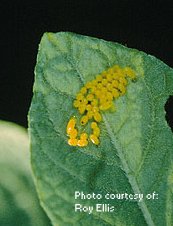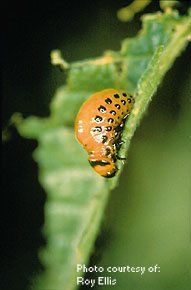Colorado Potato Beetle




Feeding on the leaves and stem tips can limit tuber development in potatoes. Leaf feeding has the greatest effect if it occurs within 2 weeks of peak flowering. Uncontrolled populations can completely defoliate potato plants and cause a total loss of tuber production. Potato beetles may be vectors of spindle tuber, bacterial wilt, and ring rot.
Host Crops
Potatoes, tomatoes, dry beans, cabbage, pepper, pigweed, smartweed, ground- cherry, thistle, lamb's quarters, and other plants in the nightshade family.
Biology
The adult beetle is fairly large, about 9.5-10 mm (3/8 in.) long and 6.5 mm (1/4 in.) wide. Its rounded outer wings form a hard "shell" marked with 10 alternating black and yellow stripes. The head is a tan-orange colour, with black markings. The yellowish-orange eggs are found in clumps of 20-40 on the underside of leaves. The fat, soft-bodied larva has a smooth-skinned, creamy- reddish-tan, humped-back body with 2 rows of black spots along each side.
Adult beetles overwinter in the soil or under litter in fields, gardens, or fence rows. They begin to emerge from their overwintering sites in late May to search for suitable host plants where the females feed and lay eggs on leaves.
The eggs hatch into larvae in 4-15 days, depending on temperature. Small, dark grubs, about 2.5 mm (1/8 in.) long, emerge from the eggs. The larvae begin to feed on leaves during June, often in exposed locations on the upper part of the plant. After 2-4 weeks of feeding, the larvae are fully-grown. Mature larvae drop to the ground, burrow 7.5-15 cm (3-6 in.) deep and form a pupal "chamber" by beating against the soil around them until it is hard and compact. There are reports that it may burrow down 1 m (40 in.) in light sandy soil.
Larvae then moult once to become yellow-coloured pupae. The new adults emerge 2-3 weeks later, depending on temperature, and dig their way to the surface. The new adults feed on leaves, then mate and lay eggs. There is usually one brood of larvae per year.
May |
June |
July |
August |
September |
| Adults leave overwintering sites | Females lay eggs, larvae start to feed | Larval feeding continues, pupation begins | Pupation continues, some adults emerge and mate | Adults continue to mate and begin to overwinter |
Scouting Techniques
Monitoring should begin when plants begin to sprout early in the season. Larvae and adults are easily seen feeding on the leaves.
Inspect 30 linear metres (100 ft.) of row for every 30-40 acres of field size. Do this by visually inspecting 3 m (10 ft.) of row at 10 different, random sites. Never inspect fewer than 10 sites, regardless of field size. Do not deliberately choose a particular section of row. One way to sample randomly is to walk a zig- zag path across the field without looking at plants for injury, then stop and make your inspection. Spread your sample sites across the entire field. Walk a different path every week.
Inspect each 3 m (10 ft.) row section for larvae. Record the number of plants in each section that have at least one larval colony. Do not count larval numbers, just the plants with larvae. Total the number of infested plants for each set of 10 samples. If you inspect more than one set of 10 samples, determine the average number of infested plants per 30 m (100 ft.).
Economic Thresholds
Treatment is usually necessary in commercial potato fields when about 10% defoliation is found. Potatoes can tolerate up to 20-25% defoliation before yields will be affected.
Consult the provincial Guide to Crop Protection for detailed information on economic thresholds.
Control Tips
Time the first treatment when 15-30% of the first egg masses have begun to hatch.
Insecticide resistant populations have been identified on the Prairies. Consult your provincial agricultural representative for current information on dealing with such populations.

